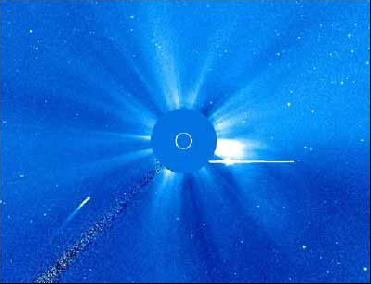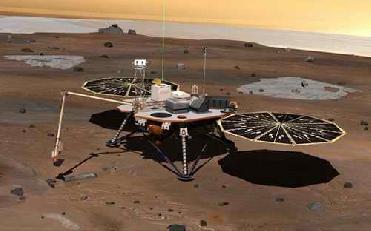
Comet 96P/Machholz (lower left) comes very close to the Sun, whose light is blocked in this 2002 image taken by the SOHO spacecraft. Photo credit: SOHO/LASCO/ESA/NASA
WASHINGTON (BNS): Astronomers have detected an alien comet in the Solar System called Machholz 1. It is thought to have been hurled out of the stellar system by the gravity of giant planets.
Scientists assume that the comet should have been wandering around out there, and sometimes came flying through the Solar System. However, no comet has been found moving fast enough to be identified as an extrasolar interloper.
Scientists believe that if Machholz 1 did fly in from interstellar space, a chance encounter with Jupiter could have made it a captive in the Solar System. This would be an extraordinary discovery, but further evidence is needed to confirm whether the alien origin is any more than a hypothesis. Fortunately, Machholz 1 will be closer to the Sun again in 2012, when astronomers can study its bright coma of gases.
David Schleicher of the Lowell Observatory in Flagstaff, Arizona, measured the chemical makeup of 150 comets and found that they all had similar levels of the chemical cyanogen (CN) except for Machholz 1, which has less than 1.5 per cent of the normal level. Along with some other comets, it is also low on the molecules carbon2 and carbon3.
The discovery of Machholz 1 could be attributed to three things. The easiest is that Machholz 1 could have formed in an extremely cold region of the Solar System. The other comets depleted in carbon2 and carbon3 are thought to have formed in the chilly outer regions of the Kuiper belt far beyond Neptune, where the low temperatures mean that most carbon gets trapped in other molecules. "In really extreme cold, maybe the cyanogen goes away as well," Schleicher said.
A second reason could be the comet's peculiar orbit. Machholz 1 approaches very close to the Sun on its orbit, closer even than Mercury, so it is possible that repeated baking by the Sun's heat has removed most of its cyanogens, he said.
Schleicher was quoted in the New Scientist journal as saying that the third and more exciting idea could be that Machholz 1 is an alien. "An extrasolar origin makes it easy to explain the composition -- of course we'd expect everything to be different. Here, three molecules with carbon are all depleted, so maybe carbon is depleted across the board? That sounds to me as if it came from somewhere else and is not just an oddball from the Solar System," he said.
Meanwhile, David Jewitt of the University of Hawaii is happier with the data on Machholz 1. "The question is how to make the jump from measuring chemical depletions to a conclusion about where the comet originated. We don't know enough to do that with any certainty. Still, the observational result is a good one and Schleicher�s speculation about the source of the comet is very...stimulating," Jewitt was quoted in the journal.
 Previous Article
Previous Article Next Article
Next Article













The Indian Air Force, in its flight trials evaluation report submitted before the Defence Ministry l..
view articleAn insight into the Medium Multi-Role Combat Aircraft competition...
view articleSky enthusiasts can now spot the International Space Station (ISS) commanded by Indian-American astr..
view article